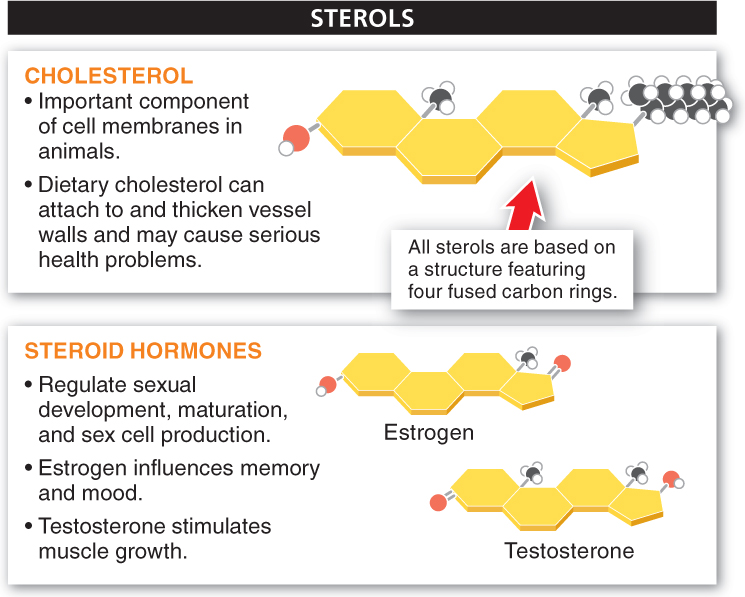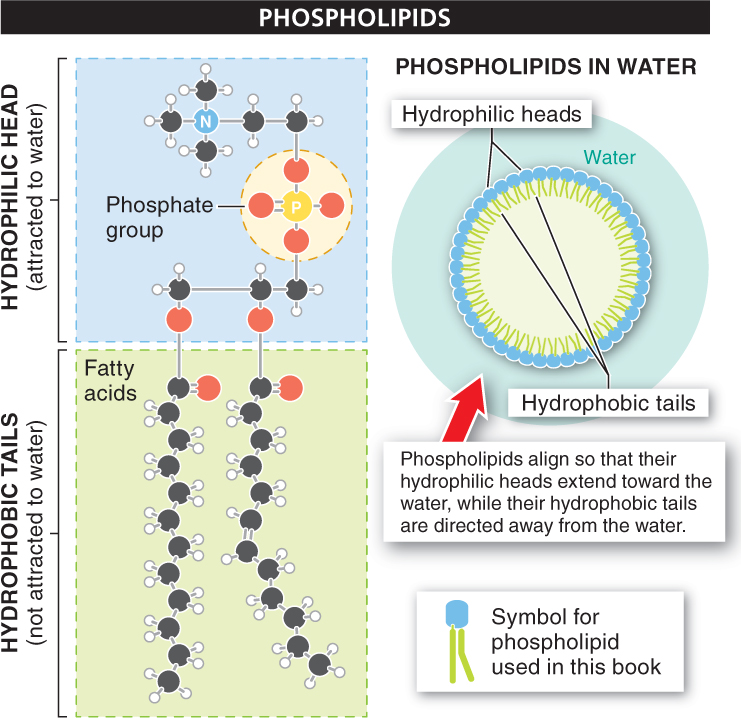Not all lipids are fats, nor do lipids necessarily function in energy storage. A second group of lipids, called the sterols, plays an important role in regulating growth and development (FIGURE 2-33). This group includes some very familiar lipids: cholesterol and the steroid hormones such as testosterone and estrogen. All of these molecules are variations on one basic structure formed from four interlinked rings of carbon atoms.

Cholesterol is an important component of most cell membranes. For this reason, it is an essential molecule for living organisms. Cells in our liver produce almost 90% of the circulating cholesterol by transforming the saturated fats in our diet. Cholesterol is also present in foods and has a bad reputation in most Western cultures that is mostly well deserved. When we ingest too much cholesterol (present in animal-
The steroid hormones estrogen and testosterone are built through slight chemical modifications to cholesterol. These hormones are among the primary molecules that direct and regulate sexual development, maturation, and sperm and egg production. In both males and females, estrogen influences memory and mood, among other traits. Testosterone has numerous effects, one of which is to stimulate muscle growth. As a consequence, athletes (particularly bodybuilders) have often been found to take synthetic variants of testosterone to increase their muscularity (FIGURE 2-34). But the use of these supplements is often accompanied by dangerous side effects, including extreme aggressiveness (“’roid rage”), high cholesterol, and, following long-

66
Phospholipids and waxes are also lipids. Phospholipids are the major component of the membrane that surrounds the contents of a cell and controls the flow of chemicals into and out of the cell (FIGURE 2-35). They have a structure similar to fats, but with two differences: they contain a phosphorus atom (hence phospholipids) and they have two fatty acid chains rather than three. We explore the significant role of phospholipids in cell membranes in the next chapter.

Waxes resemble fats but have only one long-
TAKE-HOME MESSAGE 2.14
Cholesterol and phospholipids are lipids that are not fats. Both are important components in cell membranes. Cholesterol also serves as a precursor to steroid hormones, important regulators of growth and development.
How would you define sterols to distinguish them from fats? What do they have in common with fats? Name two types of sterols, and describe their functions in the body.
Sterols are lipids with a basic structure formed from four interlinked rings of carbon atoms. Sterols play important roles in regulating growth and development. Like fats, all sterols are hydrophobic. Two common sterols are cholesterol and the steroid hormones. Cholesterol is an important component of most cell membranes (structural function). The steroid hormones, such as estrogen and testosterone, assist in directing and regulating sexual development, maturation, and sperm and egg production, among other roles.
67